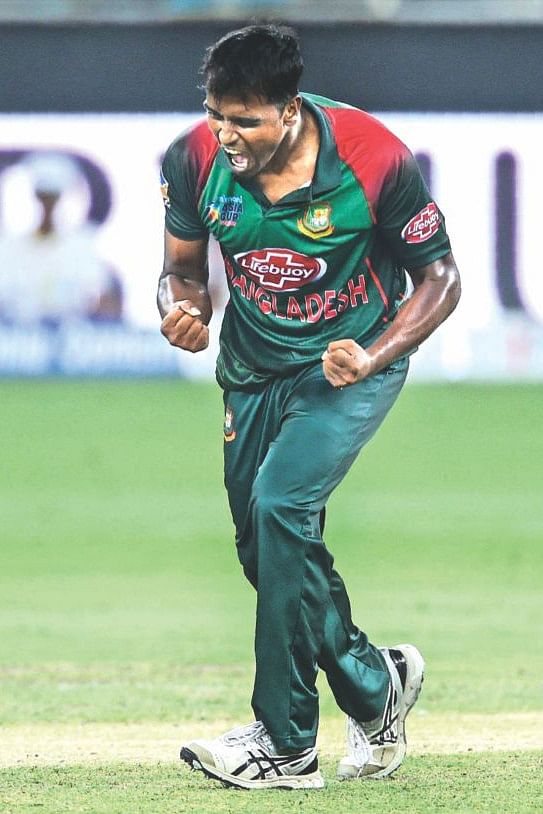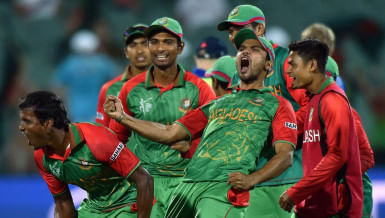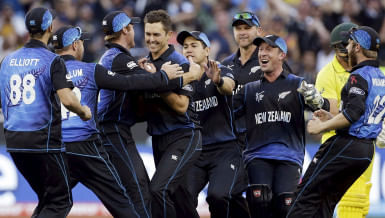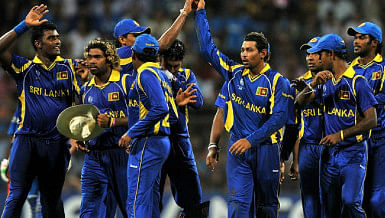Rubel Hossain is known for blowing hot and cold in a career spanning over a decade. Prone to err in the death overs, the right-arm pacer with a slinging action perhaps bowled his best ten overs in the one-day international against India in the Asia Cup final on Friday. His figures of 10-2-26-2 was a demonstration of how well he bowled in Dubai. He had Ravindra Jadeja caught in the 48th over, which was his last over, to create that window for a late twist in a pulsating final that Bangladesh lost off the last ball of the game.

Related Topics
Related News
When South Africa captain Faf du Plessis won the toss and elected to field, a few of the more faint-hearted nature feared that Bangladesh may suffer a fate similar to their sub-continental neighbours, Pakistan and Sri Lanka. But the Tigers blew those fears away with the kind of batting that they have been displaying more often than not since their rise in the last World Cup four years ago.
In what was their opening World Cup match after four years at The Oval in London, the Tigers stroked their way to 330 for six -- their best effort in ODI cricket and also the highest innings total in this World Cup so far.
South Africa needed to create history to win the game -- no team batting second in a World Cup match have ever toppled a score of 330 -- and, although the Proteas tried their best in a pulsating encounter, they eventually fell 22 runs short of the target.
It was nice to hear one of the commentators remark after Bangladesh had clinched the game that it was not an upset, but a deserving reward for an up-and-coming Tigers. His statement was not something out of context but recognition of the progress the Tigers have made so far.
That progress was reflected in every facet of the game, in which the South Africans tried with all their resources to put a pause to.
The Tigers were not scared of the famed South African pace attack. They did not falter against short-pitched deliveries like Pakistan had against the West Indies a couple of days ago when the former champions were shot out for 105. Nor did they stumble against a quality pace attack as Sri Lankan had done against New Zealand when they were bundled out for 136.
They counterattacked with such authority that it forced Du Plessis to opt for alternative options. Young opener Soumya Sarkar set the tone for a very good total with a sublime 42 off 32 balls. The way the left-hander batted against the express pace of Kagiso Rabada and Lungi Ngidi was a spectator’s delight. It was not his raucous pull shots or exquisite cover drives, but the world of time he got that mesmerized fans most. He is increasingly becoming an asset at the top of the order for Bangladesh.
And opponents beware! If he could play longer innings it would have a devastating impact.
It was also a game where Bangladesh arguably showed that they were one of the few good teams who know how to construct an innings. The third-wicket partnership of 142 between Shakib Al Hasan (75) and Mushfiqur Rahim (78) was the product of a professional approach that involved minimum risk.
Unfortunately, what is still holding the Tigers back from going to championship material from pretenders was the inability of both Shakib and Mushfiqur to turn those big scores into big hundreds. Both were dismissed at a time when Bangladesh were looking capable of posting a total beyond 350.
But despite their departure, Bangladesh prospered in the last five overs thanks to another display of professional batting from Mahmudullah, who scored an unbeaten 46 off 33 balls. Mahmudullah found a perfect ally in young batsman Mosaddek Hossain (26 off 20 balls), who repaid the faith of the team management for his selection as the number seven batsman ahead of Sabbir Rahman.
The job was still half-done and the Tigers knew that South Africa would come in all-guns blazing. They did come hard and in patches appeared to have tilted the balance in their favour. But a disciplined Bangladesh bowling attack held their nerve despite some sloppy catching. Soumya dropped Miller and Mahmudullah also reacted late while attempting to grab a top-edge from the left-hander at the backward point boundary. Mushfiqur Rahim somehow amended a dropped catch by running out a confused Quinton de Kock with a direct hit.
You can win a few games with those missed chances, but you cannot win tournaments. Regardless, it was a dream start for the Tigers. The onus is now on them to disprove former New Zealand captain Brendon McCullum’s prediction that they can’t win more than one game at this World Cup.
The morning of September 29 must have broken with some harsh light for the Bangladesh cricketers in Dubai and their loyal fans back home. It was much the same on March 23, 2012, when the Asia Cup final against Pakistan was lost in the final ball in Mirpur the night before. But as time wore on in 2012, the pain of defeat gave way to a feeling of accomplishment born from the feeling that Bangladesh cricket had finally broken through and had defeated all but one of their more celebrated neighbours before falling at the final hurdle.
On Friday night, the pain of failure at the final hurdle in the final ball -- this time against India -- haunted the cricketers and cricket lovers once again. Like 2012, this pain too shall pass but there will be a different sense of accomplishment from Asia Cup 2018.
Defeating Sri Lanka in the opener, then Afghanistan and Pakistan in must-win games may sound par for the course for the team fans have come to know since 2012. However, winning two of those matches without talismanic opener Tamim Iqbal and the one against Pakistan without both Tamim and ace all-rounder Shakib Al Hasan is not something that would have been expected. Making the final in the kind of heat they had never experienced before and doing it with setbacks that would have crippled Bangladesh sides of the past marks a new level.
To accomplish that, young players who were part of the support cast -- Liton Das and Mohammad Mithun -- and those who were leaders in waiting but often seemed to need a helping hand -- Mustafizur Rahman and Mehedi Hasan Miraz -- came to the fore. That, and the tremendous fighting spirit shown by the Tigers throughout the two-week long event -- not least in taking India's chase of 222 down to the final ball on Friday -- will be Bangladesh's biggest takeaway.
"Everyone may think about the 2012 Asia Cup final, but I see it a little differently," Bangladesh opener Tamim had said on September 13, two days before the tournament opener against Sri Lanka in Dubai. "The 2012 Asia Cup was the tournament where we first got the belief that we could beat any team -- that we could be competitive.
"I remember that; not my four fifties or how we lost the final by two runs. I remember how we played as a team and beat teams that no one would have thought we could beat. We beat India and Sri Lanka, and lost two very competitive matches against Pakistan."
Little did Tamim know then that it was his injury two days later, which forced him to fly out of the Asia Cup and back home, that would contribute to this tournament being remembered as the next big step for Bangladesh after 2012.
Since 2012, Bangladesh's graph has trended upward, with occasional dips. But a common feature of that rise has been the people doing the heavy lifting. Mashrafe Bin Mortaza, Shakib Al Hasan, Tamim, Mushfiqur Rahim and Mahmudullah Riyad have been the five cricketers who have worked wonders for Bangladesh cricket over much of the last decade.
But this Asia Cup was a departure from the norm because the Bangladesh team do not often do well with setbacks, especially when they have to fight with those setbacks against oppositions perceived to be superior. That happened in this tournament too -- losing the last group game against Afghanistan and the first Super Four match against India in abject fashion were a function of them struggling to overcome the setbacks of losing Tamim, scheduling confusions and having to play three matches in four days in 40-plus degree heat.
The recovery, and the architects of the recovery, will be the source of inspiration for future campaigns. While it is true that there was magical captaincy from Mashrafe, he still had to rely on opener Imrul Kayes to fly in on Saturday night and score a match-winning fifty against Afghanistan on Sunday from number six, rescuing the side in partnership with Mahmudullah from 87 for five. Faced with non-performing opening pairs, Mashrafe took the wildcard decision to open with number eight batsman Mehedi in the final, but the youngster still had to show the courage to be a part of a 120-run opening stand with a sublime Liton. For his part, Liton was the one who had to repay his captain's continued faith, and he did so with a maiden century in the most important game of the tournament.
Mushfiqur was Bangladesh's best batsman in the tournament with scores of 144 in the opening game and 99 against Pakistan. In both those innings, however, Mithun was an indispensable foil with innings of 63 and 60 in century-plus partnerships that rescued Bangladesh from top-order collapses.
In each of Bangladesh's three wins in the tournament, someone other than the Big Five stepped up and took responsibility. The bowlers, led by Mashrafe, Mustafizur and Mehedi, were consistent throughout and the spirited fielding was the flag-bearer of the team's never-say-die spirit.
"The positives depend on the individuals. I think losing to India twice was something that I didn't desire. When Shakib and Tamim are back, the team will do well in the future if we can hold on to this spirit," Mashrafe said after the match.
There will certainly be heartbroken fans who will rue another missed opportunity, another last-ball failure. But this tournament showed that the ingredients long craved for outside the Big Five are very much present and the work in progress is waiting for completion with the return of the two big stalwarts.
The takeaway from this latest heartbreak is that it will just be a matter of time before bittersweet gives way to unadulterated joy.
Sarfraz Ahmed, the Pakistan captain, took the blame for his team's poor show at the Asia Cup, but said that there's time to rebuild the team for the ICC Cricket World Cup 2019.
A convincing eight-wicket win over Hong Kong in the tournament opener suggested Pakistan were going to be a force. But it was followed by an eight-wicket defeat to India, and then, following a last-over win over Afghanistan in the Super Fours, losses to India and Bangladesh. As a result, Pakistan crashed out of the tournament they have won twice in the past.
"Yes, our performance was very poor. Our batting wasn't good, and we dropped a lot of catches. Our bowling was also patchy, and that's the reason we are out of the tournament," accepted Ahmed, who had a poor run with the bat himself, scoring 68 runs in four innings.
"I still believe we have a lot of talented players in the team. Look at Fakhar Zaman. Though he didn't have a good tournament, we have to back him. Babar Azam too. Imam has, thankfully, done well, but there's also Shadab and Hasan. We have to back them and take them along with us. We have to look at our bench too. We have a pool of players, and by the time the World Cup comes, we'll have a good team," said Ahmed.
"The World Cup is quite some time away, we have other engagements before that. Australia are coming, and then there's New Zealand. So we have to review our performance and see where we are falling short.
"We are losing too many wickets early, and the middle order has had to deal with the new ball, which isn't easy, and hitting quickly in the end isn't easy on these pitches. We'll have to get together and fix these issues."
While Ahmed called the performance 'alarming', he added, "There's no need to press the panic button. Yes, we have made mistakes as a team, and as a captain, I know that I didn't do well. But no need to panic, we need to back the players, look at the positions and see if there are people outside the team who can come in."
Mashrafe Bin Mortaza had boldly stated prior the Asia Cup final against India that he was not so cheap that he would judge himself by a trophy.
That trophy has eluded the Tigers once again following India's thrilling last-ball win on Friday in the Asia Cup final at the Dubai International Cricket Stadium.
Even with all the limitations and one setback after another, Mashrafe was so close to achieving the much-desired glory for the country but ultimately, he could not put his hands on the trophy. However, we must echo sentiments of Bangladesh's ODI skipper that there is no way we can judge the brave-hearted cricketer or his brigade by their failure to break the trophy jinx.
Sporting achievements are often measured by numbers and that is precisely why it will be difficult to analyse Mashrafe's true contribution in the region's biggest cricket competition.
"The boys should feel proud," responded the Bangladesh skipper after his team's three-wicket defeat in the final. "I think they did a good job without two key members. Missing Shakib [Al Hasan] and Tamim [Iqbal] was a big blow but I think boys have done a really good job," he continued.
Mashrafe had every reason to praise his charges. But we must thank the brave-hearted Tigers leader for the way he inspired his boys to overcome all the chaos. And it looked like he put the 'fear limits you and your vision' mantra to the ears of his charges.
If it all started by encouraging Tamim Iqbal to return to the crease at the fall of Bangladesh's ninth wicket in the 47th over against Sri Lanka in the opening match to accompany centurion Mushfiqur Rahim -- who almost single-handedly guided the side to a fighting 261 with his highest ODI score of 144 -- then it ended with the startling motion that saw him inspire opener Liton Das from the dressing room by thumping his chest.
Mashrafe effortlessly carried the burden of expectations throughout the tournament.
The young cricketers' failure to meet expectations has become the centre of discussion in recent times but this Asia Cup at least provided some hope thanks to this charismatic leader who tried his best to bring the best out of Liton, Mustafizur Rahman, Mehedi Hasan Miraz, Mohammad Mithun and even a proven performer like Mushfiqur Rahim didn't hesitate to praise the Mash-impact in their performance.
It was actually a bowling effort that Bangladesh can be proud of as they seemed out of the game on numerous occasions. However, the bowlers brought them back into the contention thanks to their never-say-die attitude. And it was no exception in the final battle against India.
There were not many who believed that Bangladesh could take the game to the last ball after they managed only 222 runs despite Liton and Miraz's brilliant 120-run opening stand. Mashrafe however once again proved that he was not a man who would give up on the job before showing any fight and he rightly credited his bowlers for putting up that fight.
"I hope we won a lot of hearts," Mashrafe said.
But a true champion could not stop here and that was why he said: "The positives depend on the individuals. I think losing to India twice was something that I didn't desire. When Shakib and Tamim are back, the team will do well in the future if we can hold on to this spirit."
Yes, it was the spirit that Mashrafe injected most among his charges to win the hearts and in future that spirit will help fulfil their ambitions. Still, when Mashrafe said that "we have lot of work to do" it means a lot for future success.
 For all latest news, follow The Daily Star's Google News channel.
For all latest news, follow The Daily Star's Google News channel. 









Leave your comments